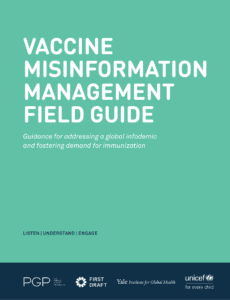Misinformation Alerts
Knowing what misinformation is being shared can help you generate effective messaging.
These insights are based on a combination of automated media monitoring and manual review by public health data analysts. Media data are publicly available data from many sources, such as social media, broadcast television, newspapers and magazines, news websites, online video, blogs, and more. Analysts from the Public Good Projects triangulate this data along with other data from fact checking organizations and investigative sources to provide an accurate, but not exhaustive, list of currently circulating misinformation.
Misinformation Alerts
Knowing what misinformation is being shared can help you generate effective messaging.
These insights are based on a combination of automated media monitoring and manual review by public health data analysts. Media data are publicly available data from many sources, such as social media, broadcast television, newspapers and magazines, news websites, online video, blogs, and more. Analysts from the Public Good Projects triangulate this data along with other data from fact checking organizations and investigative sources to provide an accurate, but not exhaustive, list of currently circulating misinformation.Alerts are categorized as high, medium, and low risk.
- High risk alerts: Narratives with widespread circulation across communities, high engagement, exponential velocity, and a high potential to impact health decisions. Are often more memorable than accurate information.
- Medium risk alerts: Narratives that are circulating in priority populations and pose some threat to health. Potential for further spread due to the tactics used or because of predicted velocity. Often highlights the questions and concerns of people.
- Low risk alerts: Narratives that are limited in reach, don’t impact your community, or lack the qualities necessary for future spread. May indicate information gaps, confusion, or concerns.
Several social media users are questioning what happened to monkeypox following the global outbreak earlier this year, with one viral post suggesting that the disease’s “marketing team” quit. The post suggests that monkeypox is not deadly and was never a real threat.
Recommendation: Emphasizing that monkeypox cases decreased globally because of the targeted awareness and vaccination campaigns spearheaded by public health and LGBTQIA+ organizations, the availability of vaccines in upper-middle- and high-income nations, and behavioral changes is recommended. Although cases have declined in many countries, monkeypox is still a threat in low-income nations like the Democratic Republic of the Congo, which was hardest hit by the disease and still lacks access to vaccines. Messaging may explain that the viral strain causing the global outbreaks is a mutation of a less deadly and more transmissible monkeypox strain that caused an outbreak in Nigeria five years ago. While it is true that the recent outbreaks were less deadly than past outbreaks, a total of 50 people have died. Fact-checking sources:
A widely shared video features an OBGYN claiming that many newborns of mothers vaccinated for COVID-19 have vaccine-induced AIDS (VAIDS). One post sharing the video claims that the vaccines have been a “disaster.”
Recommendation: Messaging may emphasize that VAIDS does not exist. Explaining that it’s a made-up term coined by vaccine opponents to dissuade people from getting vaccinated is recommended. Several large studies have found that getting vaccinated while pregnant has no negative effects on pregnancy outcomes or neonatal health. COVID-19 infection increases the risk of pregnancy complications and adverse pregnancy outcomes, making it especially important for pregnant people to get vaccinated. Fact Checking Source(s): 
In a video clip, a physician whose license was suspended for promoting COVID-19 misinformation claims flu vaccines are being used to experiment on people and that the government has been lying about the flu shot’s effectiveness for decades.
Recommendation: Emphasizing that the flu vaccines are not experimental but are the result of decades of research showing that they protect against flu infection, severe illness, and complications is recommended. Messaging may explain that annual flu vaccination is encouraged because the flu can be deadly, especially for those who are at high risk, including infants and young children, older adults, and people with preexisting health conditions. Fact-Checking Source(s): 
An image posted on social media claims to show abnormal blood clots that have been removed from the bodies of people vaccinated against COVID-19. The post claims that the vaccines caused an increase in fetal mortality.
Recommendation: Emphasizing that there is no evidence to support these claims is recommended. Despite many anecdotal stories to the contrary, no studies have found a link between COVID-19 vaccines and the “strange” blood clots that vaccine opponents frequently post about on social media. Consider countering misinformation about vaccination during pregnancy by emphasizing the numerous large studies worldwide that show that COVID-19 vaccination is safe during or before pregnancy and does not increase the risk of fetal death. Fact Checking Source(s): 
A widely shared video clip claims that a hospital in southern California has seen an increase in stillbirths since the COVID-19 vaccine rollout. A large social media account shared the video, which was viewed hundreds of thousands of times.
Recommendation: Multiple large studies have shown that COVID-19 vaccination during pregnancy does not increase the risk of miscarriage or stillbirth. Stillbirths rose dramatically in 2020, months before COVID-19 vaccines were available. This increase was likely at least partially due to COVID-19 infections, which increase the risk of several pregnancy complications, including stillbirth. Fact Checking Source(s): 
An article published by an anti-vaccine organization claims that COVID-19 vaccines are causing first-time seizures. The article includes an anecdote about a friend of the author who had a seizure and claimed it might be related to his COVID-19 vaccination.
Recommendation: Emphasizing that the article did not identify a link between the vaccine and seizures is recommended, as is explaining that a health event occurring in the days after vaccination is not evidence that the vaccine caused the event. The article, which was authored by a controversial cardiologist who promotes vaccine misinformation and fake COVID-19 cures, presents no evidence that COVID-19 vaccines cause first-time seizures or increase seizure risk. Besides the anecdote, the article cites a case study about a young man who had a seizure shortly after being vaccinated and a 2021 review article that identified a few reported instances of seizures following vaccination that could not be conclusively linked to COVID-19 vaccines. The review concluded that the benefit of COVID-19 vaccines greatly outweighs the potential risk of adverse events. Messaging may emphasize that data from clinical trials and large-scale studies in millions of people worldwide have shown repeatedly that COVID-19 vaccines are safe and that serious side effects are very rare. Fact Checking Source(s): 
In a social media post with tens of thousands of engagements, a user claims that her husband developed myocarditis and a chronic, fatal heart condition after receiving the Moderna COVID-19 vaccine. The account has frequently promoted misinformation about vaccine safety and, in the last year, has claimed that vaccines caused severe injuries to herself, her aunt, and even her dog.
Recommendation: Serious side effects from COVID-19 vaccines are exceedingly rare, and it’s up to health and legal authorities to determine whether adverse events are related to vaccination. Emphasizing that anti-vaccine accounts often use unverified stories about vaccine injuries to promote misinformation and discourage vaccination is recommended. Messaging may also explain that a common tactic of vaccine opponents is circulating unsubstantiated stories about injuries and deaths that they claim are related to vaccination. Fact Checking Source(s): 
A physician-researcher who gained prominence for promoting COVID-19 conspiracy theories recently claimed that the flu vaccine is “built on a lie.” In a video clip, he falsely claims that the purpose of the vaccine is not to protect against the flu but to indoctrinate people into taking a vaccine every year.
Recommendation: Messaging may explain that decades of research show that the flu shot protects against infection and reduces the risk of serious illness and complications from the flu. Annual flu vaccination is encouraged because the flu can be quite severe and even deadly, especially in those who are very young, very old, pregnant, or have preexisting health conditions. Fact-Checking Source(s): 
An anti-mandate account posted an image to social media mocking a person receiving a vaccination while wearing a mask for being injected with “unknown substances” while being “afraid to breathe air.”
Recommendation: The post misrepresents some basic facts, including that masks do not prevent breathing and that there are no unknown substances in COVID-19 vaccines. Consider countering these misconceptions by emphasizing the transparency of vaccine ingredients. Messaging may also explain that the ingredient lists for the authorized COVID-19 vaccines have been available for nearly two years and that nearly two-thirds of the world’s population is fully vaccinated. Fact-checking sources:
An image that is circulating on multiple social media platforms insinuates that COVID-19 vaccines are causing a global cancer epidemic. The image shows a fact-checking article from last year that debunked the claim that COVID-19 vaccines cause cancer next to a news headline about a study that found an increase in cancer worldwide in people under the age of 50. By placing the two headlines together, the post urges readers to assume causation.
Recommendation: Emphasizing that there is no link between COVID-19 vaccines and cancer is recommended. In addition, the data on the cancer epidemic predates the pandemic by nearly a decade. The study reviewed cancer data that was published between the 1990s and the early 2010s and found that cancer rates in younger adults have been trending upward for decades. Reiterating that COVID-19 vaccines are safe and that severe side effects are extremely rare is recommended. Fact Checking Source(s): 
Alerts are categorized as high, medium, and low risk.
- High risk alerts: Narratives with widespread circulation across communities, high engagement, exponential velocity, and a high potential to impact health decisions. Are often more memorable than accurate information.
- Medium risk alerts: Narratives that are circulating in priority populations and pose some threat to health. Potential for further spread due to the tactics used or because of predicted velocity. Often highlights the questions and concerns of people.
- Low risk alerts: Narratives that are limited in reach, don’t impact your community, or lack the qualities necessary for future spread. May indicate information gaps, confusion, or concerns.
Vaccine Misinformation Guide
Get practical tips for addressing misinformation in this new guide. Click image to download, or see highlights.

